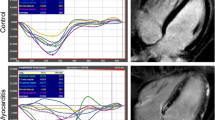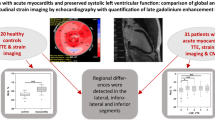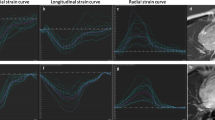Abstract
To explore the potential role of two- (2D) and three-dimensional (3D) cardiac magnetic resonance (CMR) feature tracking (FT) myocardial strain analysis in identifying sub-clinical myocardial systolic and diastolic dysfunction in acute myocarditis patients with preserved ejection fraction (EF). Prospective two centre study-control study. Thirty patients (9 female, 37.2 ± 11.8 years.) with a CMR diagnosis of acute myocarditis according to the Lake Louise Criteria and preserved EF (≥ 55%) were included in the analysis. CMR data from 24 healthy volunteers (11 female, 36.2 ± 12.5 years.) served as control. 2D and 3D LV tissue tracking analysis were performed in a random fashion by two double-blinded operators. Variables were checked for normality and analysed with parametric test. The baseline characteristics of myocarditis patients with preserved EF and the healthy volunteers were perfectly comparable, except for the LV mass index and T1 and T2 mapping values (p < 0.001). The results of the interobserver variability in the 2D and 3D LV CMR FT myocardial strain analysis were p > 0.42, ICC > 0.80 and η2 > 0.98. There was no statistical difference in 2D and 3D global radial, circumferential and longitudinal strain peak (%) and both systolic and diastolic strain rate (1/s) between acute myocarditis with preserved EF and healthy volunteers (all p = ns). There were no difference in 2D and 3D global radial, circumferential and longitudinal strain peak and both systolic and diastolic strain rate of the LV between acute myocarditis patients with preserved ejection fraction and healthy volunteers.



Similar content being viewed by others
References
Friedrich MG, Sechtem U, Schulz-Menger J et al (2009) Cardiovascular magnetic resonance in myocarditis: a JACC white paper. J Am Coll Cardiol 53:1475–1487. https://doi.org/10.1016/j.jacc.2009.02.007
Esposito A, Francone M, Faletti R et al (2015) Lights and shadows of cardiac magnetic resonance imaging in acute myocarditis. Insights Imaging. 7(1):99–110. https://doi.org/10.1007/s13244-015-0444-7
Faletti R, Gatti M, Baralis I et al (2017) Clinical and magnetic resonance evolution of “infarct-like” myocarditis. Radiol Med (Torino) 122:273–279. https://doi.org/10.1007/s11547-016-0723-5
Grün S, Schumm J, Greulich S et al (2012) Long-term follow-up of biopsy-proven viral myocarditis: predictors of mortality and incomplete recovery. J Am Coll Cardiol 59:1604–1615. https://doi.org/10.1016/j.jacc.2012.01.007
Mahrholdt H, Wagner A, Deluigi CC et al (2006) Presentation, patterns of myocardial damage, and clinical course of viral myocarditis. Circulation 114:1581–1590. https://doi.org/10.1161/CIRCULATIONAHA.105.606509
Anzini M, Merlo M, Sabbadini G et al (2013) Long-term evolution and prognostic stratification of biopsy-proven active myocarditis. Circulation 128(22):2384–2394. https://doi.org/10.1161/CIRCULATIONAHA.113.003092
Schumm J, Greulich S, Wagner A et al (2014) Cardiovascular magnetic resonance risk stratification in patients with clinically suspected myocarditis. J Cardiovasc Magn Reson 16:14. https://doi.org/10.1186/1532-429X-16-14
Sanguineti F, Garot P, Mana M et al (2015) Cardiovascular magnetic resonance predictors of clinical outcome in patients with suspected acute myocarditis. J Cardiovasc Magn Reson 17:78. https://doi.org/10.1186/s12968-015-0185-2
Aquaro GD, Perfetti M, Camastra G et al (2017) Cardiac MR with late gadolinium enhancement in acute myocarditis with preserved systolic function: ITAMY study. J Am Coll Cardiol 70:1977–1987. https://doi.org/10.1016/j.jacc.2017.08.044
Escher F, Westermann D, Gaub R et al (2011) Development of diastolic heart failure in a 6-year follow-up study in patients after acute myocarditis. Heart 97:709–714. https://doi.org/10.1136/hrt.2010.199489
Claus P, Omar AMS, Pedrizzetti G et al (2015) Tissue tracking technology for assessing cardiac mechanics: principles, normal values, and clinical applications. JACC Cardiovasc Imaging 8:1444–1460. https://doi.org/10.1016/j.jcmg.2015.11.001
Baeßler B, Schaarschmidt F, Dick A et al (2016) Diagnostic implications of magnetic resonance feature tracking derived myocardial strain parameters in acute myocarditis. Eur J Radiol 85:218–227. https://doi.org/10.1016/j.ejrad.2015.11.023
Doerner J, Bunck AC, Michels G et al (2018) Incremental value of cardiovascular magnetic resonance feature tracking derived atrial and ventricular strain parameters in a comprehensive approach for the diagnosis of acute myocarditis. Eur J Radiol 104:120–128. https://doi.org/10.1016/j.ejrad.2018.05.012
André F, Stock FT, Riffel J et al (2016) Incremental value of cardiac deformation analysis in acute myocarditis: a cardiovascular magnetic resonance imaging study. Int J Cardiovasc Imaging 32:1093–1101. https://doi.org/10.1007/s10554-016-0878-0
Baeßler B, Treutlein M, Schaarschmidt F et al (2017) A novel multiparametric imaging approach to acute myocarditis using T2-mapping and CMR feature tracking. J Cardiovasc Magn Reson 19:71. https://doi.org/10.1186/s12968-017-0387-x
Lee JW, Jeong YJ, Lee G et al (2017) Predictive value of cardiac magnetic resonance imaging-derived myocardial strain for poor outcomes in patients with acute myocarditis. Korean J Radiol 18:643–654. https://doi.org/10.3348/kjr.2017.18.4.643
Luetkens JA, Schlesinger-Irsch U, Kuetting DL et al (2017) Feature-tracking myocardial strain analysis in acute myocarditis: diagnostic value and association with myocardial oedema. Eur Radiol 27:4661–4671. https://doi.org/10.1007/s00330-017-4854-4
Caforio ALP, Pankuweit S, Arbustini E et al (2013) Current state of knowledge on aetiology, diagnosis, management, and therapy of myocarditis: a position statement of the European society of cardiology working group on myocardial and pericardial diseases. Eur Heart J 34(2636–2648):2648. https://doi.org/10.1093/eurheartj/eht210
Perfetti M, Malatesta G, Alvarez I et al (2014) A fast and effective method to assess myocardial hyperemia in acute myocarditis by magnetic resonance. Int J Cardiovasc Imaging 30:629–637. https://doi.org/10.1007/s10554-014-0371-6
Luetkens JA, Homsi R, Sprinkart AM et al (2016) Incremental value of quantitative CMR including parametric mapping for the diagnosis of acute myocarditis. Eur Heart J Cardiovasc Imaging 17:154–161. https://doi.org/10.1093/ehjci/jev246
Messroghli DR, Moon JC, Ferreira VM et al (2017) Clinical recommendations for cardiovascular magnetic resonance mapping of T1, T2, T2* and extracellular volume: a consensus statement by the society for cardiovascular magnetic resonance (SCMR) endorsed by the European association for cardiovascular imaging (EACVI). J Cardiovasc Magn Reson 19:75. https://doi.org/10.1186/s12968-017-0389-8
Danilouchkine MG, Westenberg JJM, de Roos A et al (2005) Operator induced variability in cardiovascular MR: left ventricular measurements and their reproducibility. J Cardiovasc Magn Reson 7:447–457
Schulz-Menger J, Bluemke DA, Bremerich J et al (2013) Standardized image interpretation and post processing in cardiovascular magnetic resonance: society for cardiovascular magnetic resonance (SCMR) board of trustees task force on standardized post processing. J Cardiovasc Magn Reson 15:35. https://doi.org/10.1186/1532-429X-15-35
Weigand J, Nielsen JC, Sengupta PP et al (2016) Feature tracking-derived peak systolic strain compared to late gadolinium enhancement in troponin-positive myocarditis: a case–control study. Pediatr Cardiol 37:696–703. https://doi.org/10.1007/s00246-015-1333-z
Kempny A, Fernández-Jiménez R, Orwat S et al (2012) Quantification of biventricular myocardial function using cardiac magnetic resonance feature tracking, endocardial border delineation and echocardiographic speckle tracking in patients with repaired tetralogy of Fallot and healthy controls. J Cardiovasc Magn Reson 14:32. https://doi.org/10.1186/1532-429X-14-32
Wang J, Khoury DS, Thohan V et al (2007) Global diastolic strain rate for the assessment of left ventricular relaxation and filling pressures. Circulation 115:1376–1383. https://doi.org/10.1161/CIRCULATIONAHA.106.662882
Flachskampf FA, Biering-Sørensen T, Solomon SD et al (2015) Cardiac imaging to evaluate left ventricular diastolic function. JACC Cardiovasc Imaging 8:1071–1093. https://doi.org/10.1016/j.jcmg.2015.07.004
Dick A, Schmidt B, Michels G et al (2017) Left and right atrial feature tracking in acute myocarditis: a feasibility study. Eur J Radiol 89:72–80. https://doi.org/10.1016/j.ejrad.2017.01.028
Aquaro GD, Pizzino F, Terrizzi A et al (2018) Diastolic dysfunction evaluated by cardiac magnetic resonance: the value of the combined assessment of atrial and ventricular function. Eur Radiol 29(3):1555–1564. https://doi.org/10.1007/s00330-018-5571-3
Jasaityte R, Heyde B, Ferferieva V et al (2012) Comparison of a new methodology for the assessment of 3D myocardial strain from volumetric ultrasound with 2D speckle tracking. Int J Cardiovasc Imaging 28:1049–1060. https://doi.org/10.1007/s10554-011-9934-y
Liu B, Dardeer AM, Moody WE et al (2018) Reference ranges for three-dimensional feature tracking cardiac magnetic resonance: comparison with two-dimensional methodology and relevance of age and gender. Int J Cardiovasc Imaging 34:761–775. https://doi.org/10.1007/s10554-017-1277-x
Kindermann I, Barth C, Mahfoud F et al (2012) Update on myocarditis. J Am Coll Cardiol 59:779–792. https://doi.org/10.1016/j.jacc.2011.09.074
Andre F, Steen H, Matheis P et al (2015) Age- and gender-related normal left ventricular deformation assessed by cardiovascular magnetic resonance feature tracking. J Cardiovasc Magn Reson 17:25. https://doi.org/10.1186/s12968-015-0123-3
Acknowledgements
This research was partially supported by a grant from the Italian Ministry of Health: “Giovani Ricercatori—Ricerca Finalizzata”, project number GR-2013-02356832. The funder had no role in this study.
Author information
Authors and Affiliations
Corresponding author
Ethics declarations
Conflict of interest
All the authors are aware of the content of the manuscript and have no conflict of interest.
Ethical approval
All procedures performed in studies involving human participants were in accordance with the ethical standards of the institutional and/or national research committee and with the 1964 Helsinki declaration and its later amendments or comparable ethical standards.
Informed consent
Informed consent was obtained from all individual participants included in the study.
Additional information
Publisher's Note
Springer Nature remains neutral with regard to jurisdictional claims in published maps and institutional affiliations.
Rights and permissions
About this article
Cite this article
Gatti, M., Palmisano, A., Faletti, R. et al. Two-dimensional and three-dimensional cardiac magnetic resonance feature-tracking myocardial strain analysis in acute myocarditis patients with preserved ejection fraction. Int J Cardiovasc Imaging 35, 1101–1109 (2019). https://doi.org/10.1007/s10554-019-01588-8
Received:
Accepted:
Published:
Issue Date:
DOI: https://doi.org/10.1007/s10554-019-01588-8




